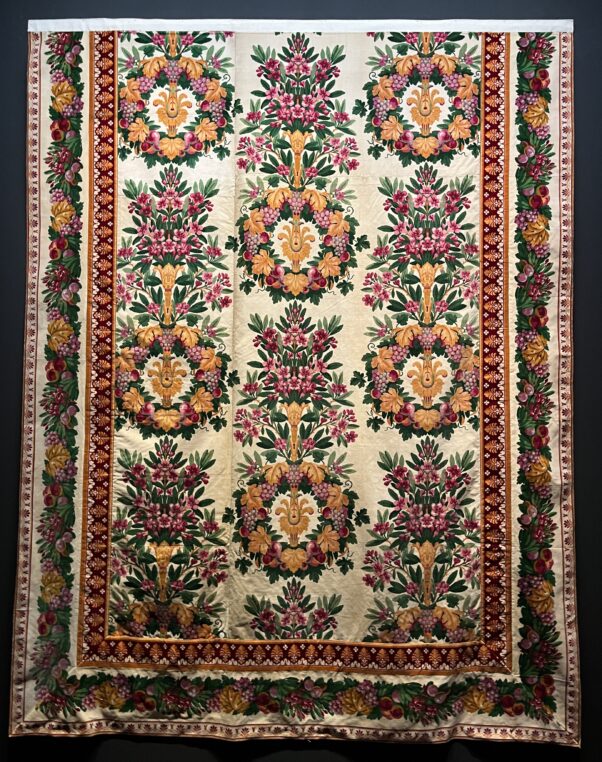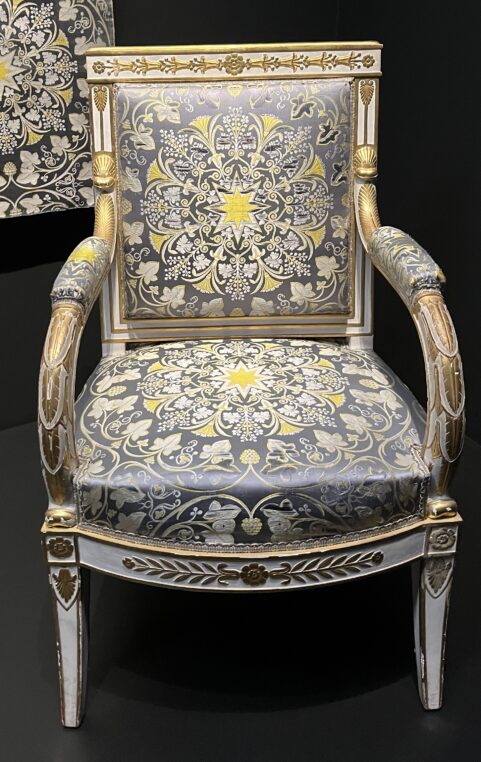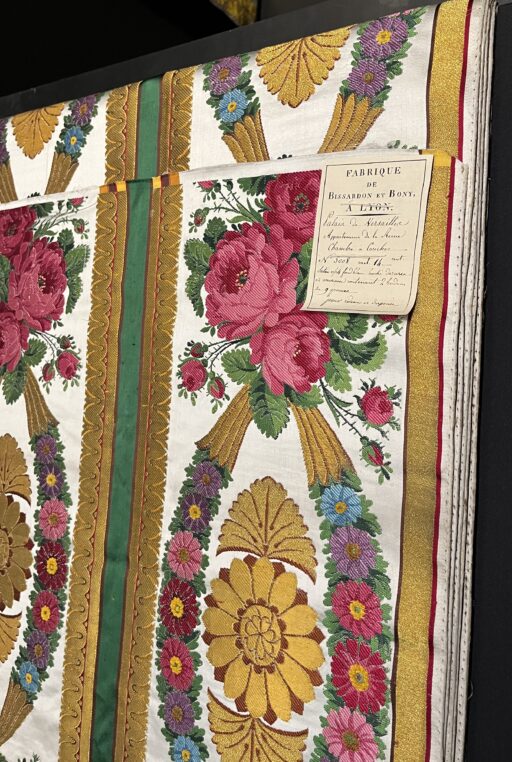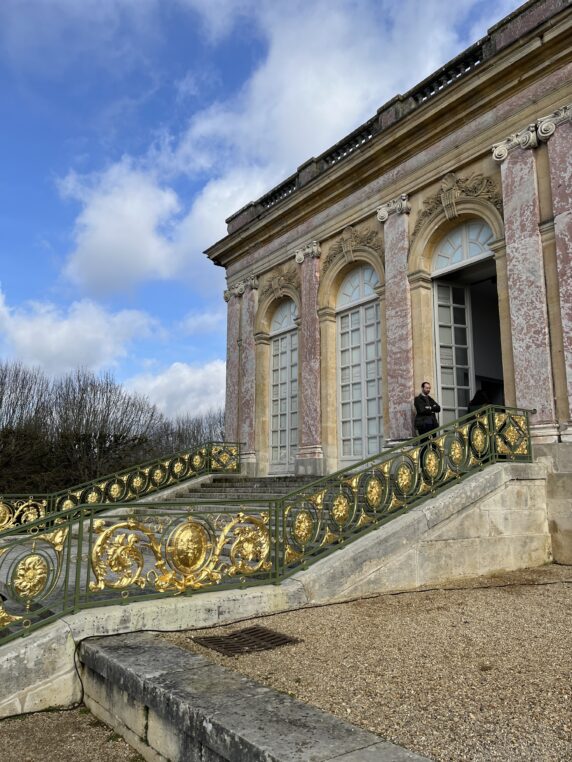
Jean-François Bony and Bissardon, Cousin & Bony, fabric for the resting cabinet of the Empress’ little apartments, 1811-1812, Mobilier National
This morning at Versailles, I discovered that we owe one important historical moment to the Brits: in sending Napoleon to Elba in April 1814, they prevented Versailles from being turned into a Napoleonic castle with a new façade and new apartments for all his family and military aides. All the plans for the elevation and the decors were recently acquired and the 80 kms of silk manufactured in Lyon for this project, were for most part kept at Mobilier National which is better known for its precious furniture and Gobelins tapestries. The new exhibition “Imperial silks for Versailles” takes place at the Grand Trianon and is the result of a successful collaboration between Muriel Barbier, formerly at Mobilier National and now director of the collections of Château de Fontainebleau (another Napoleonic castle) and Noémie Wansart, scientific advisor at Château de Versailles. With the daffodils in bloom outside and the glittering silks inside, our spirits were at their highest during the visit.
Convinced that the Lyon silk factories were financially threatened by the aftermaths of the French Revolution, the Emperor decided to allocate them 2 million Francs which resulted in the making of 80 kms of precious fabric between 1811 and 1813. The meticulous Imperial administration kept track of every technique used, every fault in the making and thanks to these archives we can recreate the amazing adventure of this pharaonic (planned) redecoration of Versailles which would never be. 120 samples of fabric are shown here and we follow the evolution of the companies which were bought out over the years. Today, Tassinari & Chatel were bought by Lelièvre who lent a few documents.

Grand Frères, Element of fabric for the third salon of the Emperor’s grand apartment, 1811-1813, velours coupé chiné(silk), Paris Mobiler National
But it all started with Camille Pernon (1775-1808) who made extraordinary fabrics for Marie Antoinette and the Spanish, Polish, Russian and Swedish courts. He alerted Napoleon as early as 1802 to the need to employ Lyon silly manufacturers who risked bankruptcy. He soon creates nine silks ensembles for Palais de Saint Cloud. But in 1807, he is sued for a fault in the die and he has to sell his manufacture to his deputies the Grand brothers. This is just after the Emperor ordered 113 meters of brocart with the eagle and the N as well as the cross of the Legion of honor for the future Room of the Throne.

Pierre Antoine Bellanger, armchair, and Tassinart & Chatel (silk) modern fabric after Camille Pernon’s lapis and white damascus silk
Different techniques of silk weaving were employed by the 28 manufacturers who were hired for this ambitious endeavor. There were 200 silk makers in Lyon at the time using up to 13 300 weaving looms and as many workers! Next to the pieces of fabric, large paintings on paper or “mise en carte” show the projected designs. Lacostat & Cie, Cartier Fils & Cie, Chuard & Tie, Cordelier & Lemire, J.M. Sériziat & Cie, Dutilieu & Theoleyre, all have samples of their creations in the galleries. And the room with the Empress’ “cabinet de repos” realized by the designer Bony is the peak of the exhibition with its embroidered birds and flowers.

The Emperor’s little apartment is exceptionally open during the exhibition. Here Camille Pernon’s fabric created for St Cloud is re-used for his bedroom in 1810
After the Emperor was deposed, 68 403,86 meters of fabric remained in the warehouses of the Mobilier Impérial. Part of it was used during the Restoration, by the Duchesse de Berry in the Tuileries and Elysées palaces and in the apartment of Duc d’Orléans in the Marsan Pavilion. Louis Philippe gave the wall hangings of the Empress’ apartment to Blais the maker of liturgical garments. This was “an expense to last a hundred years”.

Noémie Wansart explains how the Empress’s bedroom silk was turned into ecclesiastical clothes by King Louis Philippe in 1838-1842
There are many technical cabinets in the exhibition were you can watch videos of the weaving and understand the coloring of the threads. A model of a Jacquard machine is lent by the Musée des Tissus et des Arts Décoratifs de Lyon. It is a weaving loom invented in 1801 with a mechanism in which a set of tools connected to needles operated by punched cards, lift the warp threads. This machine invented by Joseph-Marie Jacquard revolutionized the weaving of figured fabrics.
One goes through the exhibition like reading a thriller on the silk industry. Napoleon’s extravagant plans are scary retrospectively and the two young curators have done an extraordinary job at uncovering the uses of the fabric after the emperor’s death.
The exhibition is on until June 23 at Grand Trianon in Versailles. You can access with your car (for a fee of 12€) through Grille de la Reine. On a sunny day, it is a great promenade to Petit Trianon and around the Grand Canal.
Share this Post



8 Comments on “Imperial silks for Versailles at the Grand Trianon”
Passionnant article. Merci Laure
This is incredible – what a wonderful idea for an exhibition. Thank you Laure for sharing it with us in this brilliant article.
What a wonderful article ! Thanks. Who knew ? Theo
I am delighted this exhibition has been inaugurated and your writing about it is both fascinating and enlightening. I took a group years ago during Paris Déco Off to see the archives as Tassinari and we were shown some of the textiles Napoleon had ordered for his magnus opus.
So glad that Versailles chose to put this exhibition together for the general public.
Marvelous account! It made me feel as I was with you viewing the exhibition.
Fascinating historical account brought alive by your words.
Une nouvelle fois, la communication presse de Versailles est erratique. Pas au courant.
Lecture de cet article qui se lit avec un grand plaisir ET l’envie de découvrir cette exposition. Incroyable, une commande de 80 kilomètres.
Bravo, but I keep saying bravo week after week.
Fantastique ! Un grand merci. Grâce à toi j’y cours (-: